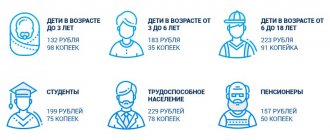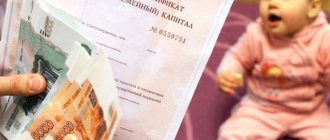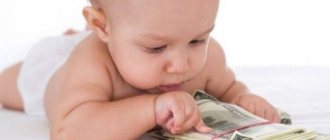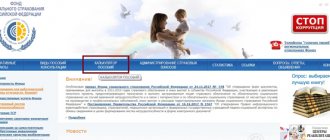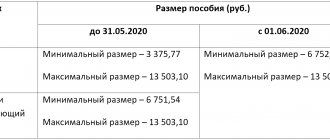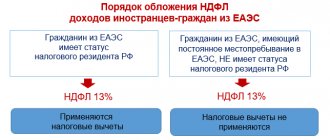What kind of payments are there?
Benefits for 2 children are divided into one-time and monthly.
One-time benefits:
- for registration at the antenatal clinic (LC) before 12 weeks of pregnancy;
- for pregnancy and childbirth (B&C);
- at the birth of a child;
- maternal capital.
Monthly payments:
- up to 1.5 years;
- until 3;
- before 18;
- and benefits for up to 1.5 years to low-income families from maternity capital.
Let's take a closer look.
What is benefit for a second child in 2021
Don’t know why the state pays benefits for a second child in 2021? Everything is extremely simple, according to the legislation established in the Russian Federation, families in which a second child is expected are provided with both one-time and monthly benefits from government bodies. In particular, they act as a full-fledged analogue of payments in the event of pregnancy, as well as subsidies for the birth of the first child, with the only exception that the provided amount of funds differs slightly in the direction of increase. Additionally, the state provides the opportunity to receive payment of special family (also called maternal) capital.
As of 2021, the amount of this capital is about 466,617 rubles for the first child and 616,617 rubles for the second.
Debit card All inclusive from Fora-Bank
Apply now
One-time
One-time benefits are paid once, some before the birth, for example, the benefit for registration in the housing complex and the M&R benefit, and some only after the child is born, for example, payment at the birth of the child and maternity capital.
One-time payment for those registered in the early stages of pregnancy
A woman who registered with a housing complex in the first trimester can receive a one-time benefit. In 2021, it is 655 rubles and its amount is the same for everyone and does not depend on which child is expected.
Most often, a pregnant woman issues this payment simultaneously with the payment under the BiR. In order to receive benefits, you need to provide the following documents to your employer or the Social Insurance Fund:
- certificate of incapacity for work;
- passport;
- statement.
One-time maternity benefit
The one-time allowance for BiR does not depend on the order of birth of children. Its amount is calculated on the basis of the minimum wage and the duration of the leave according to the BiR.
The benefit is granted only to employed women starting from the 30th week of pregnancy or from the 28th week if the expectant mother is expecting more than one child.
We talked in more detail about how to calculate benefits in the previous article about benefits for the first child. With the second child, the calculation algorithm is the same.
Important point: If a woman gave birth to her first child and received payments for him until 1.5 years, and then went on maternity leave after giving birth to her second child, she cannot immediately receive benefits under the BiR. You will have to choose one more profitable payment, since paying two is illegal. If a woman chooses a BiR benefit for her second child, then it is first paid to her, and only then, after the end of her BiR leave, the employer can resume payments to her for the first child up to 1.5 years old.
By the way, this is why it often happens that a benefit for up to 1.5 years is taken out by one of the relatives, for example, a grandmother, and the mother receives a benefit under the BiR.
It may not be entirely honest, but it is an absolutely legal way to receive all benefits at the same time.
One-time benefit for the birth of a child
After the child is born, the family is entitled to another benefit - a lump sum at birth. Its amount is fixed; in 2021, families are paid 17,479 rubles.
The payment is provided to both employed and unemployed people. The former apply for it to the accounting department at their place of work, the latter to social security.
Registration of benefits proceeds in the same way as in the case of the first child.
Indexation of child benefits
It is important for parents of newborns to know not only what benefits are due at the birth of a second child, but also how their value changes due to inflation.
How inflation affects the amount of tax and other payments, see our publications:
- “Excise taxes will grow along with inflation”;
- "Wage indexation".
The legislation establishes restrictions that the Social Insurance Fund must adhere to when paying child care benefits (Part 1, Article 11.2, Part 1.1, Article 14 of Law No. 255-FZ, Part 1, Article 15 of Law No. 81-FZ):
- you cannot pay benefits less than the minimum established by law;
- the amount of the child benefit should not be less than 40% of the minimum wage in force at the time the benefit was issued.
From February 2021, the benefit assigned based on the minimum wage for the second child was increased to 7,082.85 rubles.
Monthly benefits
Monthly payments are calculated identically to the same benefits for 1 child. Only the amount of benefit up to 1.5 years for the second child will be higher.
Care allowance up to 1.5 years
Benefits for up to 1.5 years are provided to both employed and unemployed people. Only the calculation principle and the total amount of payments due to them differ.
By the way, this is one of the few benefits, the amount of which depends on what kind of child is born: the first or second.
For the second and subsequent children, the state pays a benefit equal to 40% of the average salary for 2 years - for workers or equal to the minimum requirement - for the unemployed.
- The minimum benefit value established for 2021 is 6,554 rubles.
- The maximum monthly benefit is 26,152 rubles.
- Unemployed people and students are paid a minimum allowance of 6,554 rubles.
For workers, a detailed example of calculating benefits can be found in the corresponding section of our article about payments for the first child.
Payment must be made no later than 6 months after the child turns 1.5 years old. They submit documents for benefits either to social security, if the parents are unemployed or students, or to the accounting department at the place of work, if they are employed.
The documents are reviewed within 10 days, and then a benefit is assigned, which will begin to be paid no later than the 26th of the next month. The benefit can be applied for by any family member who is going to care for a child.
Child care allowance up to 3 years old
There is practically no benefit as such. There is only a small compensation for the mother's absence from work. The monthly compensation is only 50 rubles, since it has not been indexed since its inception in 1994. You need to apply for payment to the accounting department at your place of work, or to the MFC.
Payment for a second child up to 1.5 years old for low-income people
Since 2021, it has become possible to receive part of the money from the mother’s certificate in cash.
The so-called Putin payments involve monthly payments to low-income families for a child under 1.5 years old from maternity capital.
A state-issued certificate may not always be usefully used. For example, you can contribute the amount of maternity capital as a down payment on a mortgage, but the family will not be able to continue paying the loan monthly. Perhaps the family simply does not need any of the targeted areas to spend the money under the certificate, but they would not mind monthly payments in “real” money to provide for the child’s immediate needs: buy diapers, clothes, food.
Payments from maternity capital for up to 1.5 years solve these problems.
An important difference: for the poor, for the first child, the same payments for up to 1.5 years are assigned in social security and paid from social insurance funds; for the second child, payments are issued in the pension fund.
The conditions for receiving payment are the same:
- the child must be born after January 1, 2021;
- the family must be low-income, that is, the average per capita income per person in the family should not be more than 1.5 times the subsistence level in the region. The basis is the subsistence level of the working population.
Let's explain with an example:
Olga receives 25,000 rubles a month, her husband Vladimir receives 32,000 rubles a month, they had a second child and there are four of them in the family.
Let's calculate the average per capita income: you need to multiply the monthly income of the spouses by 12 months, and then divide the resulting value by 12 and then divide again by the number of family members.
25,000*12+ 32,000*12/12/4=14,250 rubles—average per capita value.
The family lives in Tyumen, where the cost of living of the working-age population in 2021 is 11,528 rubles.
One and a half living wages are equal to 17,292 rubles.
14250 is less than 17292, which means that the family is considered low-income and has the right to receive a monthly allowance from maternity capital.
You can view the current cost of living for your region on the EMISS website or find it out at the social security office or MFC.
The benefit can only be paid for up to 1.5 years and, of course, the entire amount under the certificate cannot be transferred during this time.
Returning to our example. For the second child, the family of Olga and Vladimir will be paid a monthly amount equal to the cost of living per child in the city of Tyumen, which is equal to 11,168 rubles in 2021. For 1.5 years, only 201,024 rubles will be paid - this is half of the maternity capital funds.
Accordingly, the question arises, what will happen to the remaining unused money. It's simple. The remainder can be used for any permitted purposes, for example, paying off a mortgage or putting money into the funded part of your mother’s pension.
Supporting a family with a low income
The list of benefits for the 2nd child in 2020-2021 also includes a recently introduced type of financial assistance for parents with children - monthly payments in connection with the birth (adoption) of the first or second child (law “On monthly payments to families with children” from December 28, 2017 No. 418-FZ). But not all parents and adoptive parents can count on these payments.
Law No. 418-FZ specifies the conditions, the simultaneous observance of which allows one to hope for this payment:
- the child was born or adopted no earlier than 01/01/2018;
- the newborn is a citizen of the Russian Federation;
- the size of the average per capita family income does not exceed 2 times the regional subsistence level of the working-age population for the 2nd quarter of the year preceding the year of application for payment.
This payment in 2021 is provided until the child reaches the age of 3 years.
In this case, an application for a payment is first submitted only for the first year of life. When the child reaches this age, a new application must be submitted: from 01/01/2020 - from 1 to 2 years, and then from 2 to 3 years.
For more details, see: “Presidential payments upon the birth of a child in 2021 - 2021.”
Additional subsidies and benefits
In addition to basic benefits, families in which a second child was born are entitled to a number of subsidies and additional payments.
Payments and benefits for single mothers
Single mothers cannot count on any separate federal payments and benefits. They are entitled to the same benefits for 2 children as full families.
But regional authorities can, at their discretion, assign subsidies, benefits and payments to single mothers.
For example, benefits for the purchase of food, medicine, school supplies for single mothers or payment of utility bills are common in many regions.
To apply for benefits, a woman must confirm her status with a special certificate in form No. 25, which is issued at the registry office.
Benefits and benefits for a disabled child
Benefits for a disabled child do not depend on how he was born; the amounts will be the same for 1 and 2 children. We talked more about payments for a disabled child in our article about payments for the first child.
Regional and gubernatorial payments
In most regions, families with a second child are assigned a local regional benefit.
Information about benefits and benefits can be found at the MFC or social security, as well as on the State Services website.
To receive the benefit, parents applying for it must meet the following requirements:
- registration and residence in the region;
- age up to 30 years.
These are typical conditions, but in some regions they change or are supplemented.
The timing of payments, amounts and conditions for receipt are determined by local authorities. For example, they can assign benefits only to low-income or single-parent families.
In Moscow, for 2 children, regional authorities pay an additional 7 subsistence minimums per capita - 112,609 rubles.
But in the Ulyanovsk region there is the so-called Personal Capital “Family”. For the birth of a second child, parents are entitled to 50,000 rubles.
In some regions, for example, Novosibirsk, Amur Region, additional payments are assigned only at the birth or adoption of 3 or subsequent children.
Are gubernatorial payments given for the 2nd child?
Parents of newborns can receive financial assistance not only from the federal budget. Regional authorities are also involved in supporting parents with children.
At the birth of a second child, parents can count on an additional regional financial bonus. This payment is called the governor's payment. Regional authorities determine its size differently. And in some territories there are no regional payments for a second child at all. It all depends on the demographic policy of the region and the capabilities of its budget.
In those territories where gubernatorial benefits are paid, their value can vary from 500–1000 to tens of thousands of rubles.
The amount of gubernatorial payments for the second child in 2020-2021 is also set differently: in a fixed amount or in relation to the regional minimum wage. For example, young metropolitan families with parents no older than 30 years of age and permanent registration in Moscow at the birth of a second child can count on a one-time benefit in the amount of 7 minimum wages (Moscow Law “On Youth” dated September 30, 2009 No. 39). For the calculation, the Moscow subsistence minimum established per capita is used on the date of birth of the child.
The list of recipients of gubernatorial child benefits is also determined by regional authorities. The benefit can be paid to all parents of newborns or only to those who belong to the category of large or low-income families.
To find out whether you are entitled to a governor's benefit for the birth of a second child in 2020-2021, you need to contact the social security authorities at your place of residence or the local administration.
Who pays benefits and what documents are needed
Parents can find out complete information about all benefits provided on the State Services website, at the MFC and at social security. Here you will also be given reminders with a complete list of documents required for registration of benefits. For maternity capital you need to contact the Pension Fund.
To apply for benefits, you need to prepare a standard package of documents, which will include:
- parents' passports;
- children's birth certificates;
- Marriage certificate;
- work books;
- income certificate in form 2-NDFL;
- certificate of cohabitation with the child;
- a document confirming the adoption of the child, if necessary;
- document confirming that the parent is studying at a university, if necessary.
Documents submitted to social security are reviewed within 10 days, after which benefits are assigned and paid no later than the 26th of the next month.
If the documents were submitted to the accounting department at the place of work, then they are also reviewed within 10 days and the benefit is paid along with the next salary.
Benefit money is transferred to the recipient’s card or current account, depending on the details he provided in the application.
Documents submitted to the pension fund for registration of maternity capital are reviewed within a month, after which a letter notification of the readiness of the certificate is received by mail.
Results
The state fully supports parents in their desire to give birth or adopt a second child. The expectant mother of the baby is paid a benefit for registering in the early stages of pregnancy, as well as maternity benefits. After the birth of a child, parents are entitled to one-time and regular payments (maternity capital, governor's benefits, monthly child care allowance, etc.).
To find out what payments are given for a second child in 2020-2021 by regional authorities, you should contact the social security authorities at your place of residence or the local administration.
Sources:
- Federal Law of December 28, 2017 N 418-FZ “On monthly payments to families with children”
- Decree of the Government of the Russian Federation of January 24, 2019 N 32
- Federal Law of December 29, 2006 N 255-FZ “On compulsory social insurance in case of temporary disability and in connection with maternity”
- Federal Law of May 19, 1995 N 81-FZ “On state benefits for citizens with children”
You can find more complete information on the topic in ConsultantPlus. Free trial access to the system for 2 days.
Remember
- The list of benefits for the second child is the same as for the first, with the exception of maternity capital.
- All benefits, except for benefits up to 1.5 years, have the same values or are calculated in the same way as for the first child.
- The minimum benefit value for up to 1.5 years for 2 children is 6554 rubles.
- Low-income families can receive payments for a child up to 1.5 years old from maternity capital funds. They need to be registered with the pension fund.
- Families with a second child born after January 1, 2021 can apply for preferential mortgage loans at 6% per annum.
Still have questions? Ask them below in the comments.
Dessert video: Incredible people
Regional benefits for children in Moscow
Based on bills adopted by the city authorities, Moscow residents can count on receiving the following types of child benefits in 2021:
- one-time – paid one-time if the recipient is included in the category covered by the possibility of providing the specified assistance;
- accrued monthly - if the applicant applied for the specified benefit six months after the corresponding right arose, additional payments are due within the previous six months;
- paid annually - apply to parents raising ten or more children, provided that at least one child has not reached the age of majority.
In accordance with the requirements of regional legislative acts, Muscovites are entitled to the following child benefits in 2020:
- Additional benefits in connection with the pregnancy and birth of a baby - the amount of accrual is 1,584 rubles. monthly. The appointment period is 70 (if several babies are pregnant at the same time - 84) days before the birth and for a similar period after (if the birth was difficult, it extends to 86, and in a situation with twins - up to 110 days).
- One-time payments to pregnant women upon reaching the twentieth week upon registration at the antenatal clinic - 634 rubles. The opportunity to apply for social assistance is available until the baby reaches one year of age. Available to women with Moscow registration.
- One-time compensation charges to reimburse expenses caused by the birth of a baby in the amount of 5,808 rubles for the child born first and 15,312 rubles for all subsequent ones. Paid to either parent, provided that the child lives with him in Moscow on a permanent basis. The order of payment of funds for offspring is established in relation to the common mother for all children. Not recommended for stillborn babies.
- One-time payments for triplets and more children born at the same time. The amount is 52,800 rubles. for a certain family, regardless of the number of children. Application period is within six months from the moment of birth.
- Additional one-time payments for the birth of a baby for young families. The amount depends on the cost of living in the region and the number of babies born. For one child, an allowance is paid in the amount of 5 minimum wages, for two children - 7, for three or more - 10 minimum wages. The number of children in a family is counted after the spouses are officially married.
- Monthly payments to low-income families for children under the age of majority. The amount of benefits depends on the age of the child, up to three years - 10,560 rubles. (single mothers - 15,840 rubles), age category from three to eighteen - 4,224 rubles. (for parents raising a child alone - 6,336 rubles), from three to seven - 7,613 rubles. Provided for families where the income level does not exceed the regional minimum for each member.
- Compensation accruals paid every month for a baby not older than eighteen months. The amount is 1,584 rubles. Reliable to women who lost their jobs due to the closure of the enterprise.
- Monthly reimbursement of expenses due to increased prices for essential goods. Reliable for large families, single mothers, military personnel, disabled people and pensioners supporting a child under the age of one and a half years. The amount of payments is 633 rubles.
- Similar charges for children under three years of age - the amount is 713 rubles. Intended for the above categories of recipients.
- Monthly compensation for a citizen caring for a child with a disability – 12,672 rubles. Entitled one of the parents of disabled children until the offspring reaches adulthood or twenty-three years of age (if this category has been assigned since childhood).
- Accruals every month for a child with a disability who has lost a breadwinner - 1,532 rubles. For the same age category as above.
- Monthly payments to disabled parents raising children – 12,672 rubles. Accrued if the mother and father are deprived of work and they are assigned a disability group.
- Monthly payments to large families for the purchase of children's goods - 1,901 rubles. Appointed if the number of children under the age of five or more.
- Compensatory contributions for parents supporting 10 children or more – 1,584 rubles. Accrued until the child reaches sixteen years of age.
- Similar payments to retired mothers with many children – 21,120 rubles. The amount does not depend on the size of the pension benefit received.
- Monthly additional payments to families to compensate for the cost of utilities. They are set depending on the number of children, for three or four it is 1,103 rubles, for five or more – 2,205 rubles.
- Compensation for telephone payments for parents with many children. It is paid once a month and amounts to 264 rubles, if you have the appropriate status.
- Annual payments for the celebration of Family Day. The benefit amount is 21,120 rubles, paid every year by May 15.
- Similar help for Knowledge Day. Intended for parents of ten children and paid in the amount of 31,680 rubles.
- Annual payments for the purchase of school uniforms for children. Issued 10,560 rubles per student.
The specified child benefits in Moscow in 2021 are subject to regular indexation, due to the influence of inflation processes.
Governor's payments in the south and Crimea
The southern republics are famous for their high birth rates and subsidies, so benefits in the Southern Federal District are traditionally small. In Adygea, the local one-time payment for the second newborn is 1,600 rubles. It is claimed by both permanent residents and those who primarily live in the republic. Citizenship is not required for enrollment. In addition, Adyghe residents receive a monthly payment for a child under 16 years of age. The size is influenced by family status, the health of the child (perhaps he is disabled), and the presence of other social support measures.
Families in the south of Russia are mostly large, so child benefits are small
In Ingushetia and Dagestan , whose budget is largely formed from subsidies from the federal treasury, the birth rate is high, there are quite a lot of large families, so regional laws do not provide for one-time republican financial assistance, although the system of benefits for large and poor families, of course, works.
In Kabardino-Balkaria, when their own babies are born, a family that is officially registered in the republic is given a one-time payment of three thousand one hundred and forty-nine rubles. A basic set of certificates is required to obtain it. For adopted children, poor families and those with many children, the Republican Code provides for financial assistance from the state.
In Kabardino-Balkaria there are no one-time payments for children adopted/taken under guardianship or guardianship.
Republican maternity capital is allocated for the fifth and subsequent babies, in contrast to Kalmykia, Krasnodar Territory, Astrakhan, Volgograd, Rostov regions . In these areas, it is received when the third newborn appears in the family, in Karachay-Cherkessia - the fourth. Circassians encourage the population to adopt children. A one-time governor's allowance of thirteen thousand is awarded to any adopted child. Similar cash assistance has been established in Alania (North Ossetia) and Chechnya . The amount of support is eight thousand (in Grozny, when accepting brothers and sisters into a family, it is one tenth of a million). In addition, in Ossetia, once a month, benefits are paid to citizens whose children suffered from the terrorist attack in Beslan on September 1-3, 2004. For the second baby born after this date, one and a half thousand are given for up to seven years.
In the Stavropol region, in addition to various regular benefits to poor and large families, a one-time payment of one hundred thousand is also provided, which is equally divided among all children who were supported by the deceased during a natural disaster or man-made accident, a terrorist attack or an attempt to suppress terrorist actions, and ten thousand small dependents of a military personnel killed in the line of duty.
In Volgograd, for any newborn, regardless of the way in which he came into the family (adoption, birth, guardianship, etc.), one-time assistance is paid - 11,400 rubles.
The legislation of the Republic of Crimea does not provide for one-time benefits for the birth of a second baby, but in Sevastopol in such a situation, a family will receive 139,430, which includes one-time benefits of 27,444 and regular financial assistance of 3,732 rubles every thirty days for a one and a half-year-old child until the moment. when he turns 4 years old.
Legislative regulation of the issue
Governor's payments are a one-time benefit that is paid in every region of our country.
It is worth remembering that there is no single size, and the amount of assistance varies from 2 to 150 thousand rubles, depending on the region of residence. The registration procedure itself is standard and no different.
On the territory of the Russian Federation, gubernatorial payments for children are regulated by several laws :
- Federal Law No. 81, which describes the procedure for issuing this financial assistance;
- Federal Law No. 865, which describes the basic conditions, the required list of documents and the algorithm for obtaining financial assistance.
Moreover, these legislative acts are only basic, since there are also regional ones that describe in more detail all the nuances depending on the area of residence.
Governor's payments in the Urals
In the Yamalo-Nenets Autonomous Okrug, Russian families living in the region for a year or more will receive one-time financial assistance for the birth of another baby - five thousand + an additional payment of ten for twins. In Ugra, the conditions are stricter: fifteen thousand five hundred twelve rubles for the second or sixteen thousand four hundred twelve rubles thirty kopecks for each newborn - twins or triplets, if the family has lived in the district for ten years or more. when a baby was born into a family of small indigenous peoples of the North on the territory of the Khanty-Mansi Autonomous Okrug, then for each, regardless of the number of children, they will give twenty thousand in marriage.
In Kurgan they pay forty thousand rubles for twins, in Chelyabinsk they pay three thousand for the second one. In addition, in the Chelyabinsk region, the governor allocates money to prepare children for school fifteen hundred times a year to large low-income families or families raising a child with physical or mental disabilities. In Tyumen, the governor's allowance can be received only for the third baby, and in Yekaterinburg , the mother will be awarded the allowance for the second baby once only when she gives birth to twins (5,000).
Payment amount
The amount of payments in the capital and the Moscow region is slightly different and varies within the following limits:
- In Moscow:
- The birth of the first child - about 86 thousand rubles;
- The appearance of a second child in the family – about 120 thousand rubles;
- For the third (and subsequent) born (adopted) child, the subsidy will reach 173 thousand rubles;
- For residents of the Moscow agglomeration:
- First child – 10 thousand rubles;
- Second pupil – 20 thousand rubles;
- Third and subsequent child – 30 thousand rubles;
- The appearance of twins - 70 thousand rubles;
- Multiple pregnancy and the birth of 3 or more newborns at the same time – 150 thousand rubles.
What you need to know
On January 1, 2021, the President of the country introduced another type of payment. It concerns the birth of 1 baby. If previously the state supported families mat. capital at the birth of 2 or more children, then from this year monthly assistance is provided to those families who have 1 child. Currently, the amount of this benefit is 14,252 rubles. But only low-income families can count on help.
Another innovation concerns maternity capital. If previously money could be spent only for its intended purpose, now, a similar amount can be allocated monthly from the mat. capital until the child reaches 1.5 years of age. Thus, parents who have a second child can take advantage of this payment.
State policy is currently aimed at doing everything possible to encourage families to give birth to new citizens in the country. To achieve this, various financial benefits are provided. The Moscow region is not lagging behind in this endeavor and is introducing its own payments to Muscovites. Thanks to this, parents are more confident in deciding to have children, and the birth rate is gradually increasing.
General support provisions
The Governor's Childbirth Benefit is a regional program to help families planning or already becoming parents.
The conditions and procedure for assigning these subsidies are completely established by the local authorities of the subject, and its size depends on the debit of the regional budget.
As a rule, to participate in the assistance program, applicants must meet a number of requirements, for example, have permanent residence in the region where the application for subsidy is being submitted and be the parents of one or more children.
The bulk of gubernatorial (regional) benefits are aimed at increasing the demographic situation in the subject and are one-time in nature. If a potential applicant has already had experience in receiving similar assistance, then most likely the authorized body will issue a refusal to exercise its rights to a subsidy.
Registration procedure
Citizens who apply for the governor's payment should be aware that the algorithm for receiving it is as follows:
- Collection of necessary list of documents.
- Submission of documents and preparation of the corresponding application.
- Decision-making by an authorized body.
- Receiving the governor's payment.
Where to go
To apply for this payment, applicants can contact the social protection department at their place of residence. Moreover, each of them has the right to use the services of the MFC, where they can submit the necessary list of documents in just 5 minutes.
What documents may be needed
Anyone applying for a payment must prepare the following list of documents :
- application for payment;
- originals and copies of birth certificates of the first and second child;
- original and copy of the applicant’s passport (all pages);
- bank details for transferring funds (if you have a passbook, you must present a copy, otherwise you will have to open a bank account).
It is worth noting that in most cases, several birth certificates are required in order to prove the fact that financial assistance is not provided for the first child.
